
Both the founder and designer of Mountain Research, Setsumasa Kobayashi began his first line, General Research in 1994, later changing the name to Mountain Research in 2006. Despite having no formal education in fashion, Kobayashi approaches design with the dedicated and in-depth approach of an academic and has built a vibrant career, spanning more than 25 years in both footwear and clothing. Delving deep into the minutia of every item he creates, Kobayashi finds a way to meld disparate elements, ranging from the outdoors and military clothing to anarchism, motorcycles and literature, creating his own distinct universe. With a highly conceptual lens on fashion, it’s hard to imagine that a Phish concert in the woods was the catalyst for Mountain Research.
It is no mystery that nature is deeply woven into Kobayashi’s DNA. Splitting his time between Tokyo and his unique, custom-built retreat in the Nagano mountains, he lives the eternally balanced lifestyle. Sitting in his atelier, I look up and observe the sea of vintage and personal designs he has on display. With live recordings of Phish playing in the background, I sit down with the man of many layers as he opens up about the collaborative process behind the HAVEN / Mountain Research collection and his journey creating Mountain Research.
世の学者や歴史家のごとく、常に探究心を持ち続ける〈マウンテンリサーチ〉のデザイナー小林節正さん。靴作りからキャリアをスタートした後に、自身のブランド〈ジェネラルリサーチ〉を1994年に立ち上げ、2006年から〈マウンテンリサーチ〉にシフトし現在に至るまで歩みを落とすことなく学び続ける。ときにはミリタリーやバイクウェアなど他分野をまたぎつつ、どの題材においても好奇心とインスピレーションを発揮し注ぎ込んでいる。
そもそも〈マウンテンリサーチ〉が誕生したきっかけは、メイン州の森の中で行われたフィッシュのライブ体験だと語る。また、幼少期から青年期に過ごした自然の中での体験もプロダクトのDNAに深く刻み込まれているようだ。そんな小林さんは現在、東京を拠点にしながらも休日は長野の山にある基地、あるいはプライベートキャンプ場で時間を過ごすという、バランスの取れたライフスタイルを送っている。
2020年3月に披露される〈ヘイブン〉と〈マウンテンリサーチ〉のコラボレーションライン発売を目前に、小林さんにインタビューする機会をいただいた。東京は中目黒にあるアトリエを訪問すると、自身のビンテージコレクションと過去にデザインを手掛けたアイテムで埋め尽くされた空間が広がっている。ブランドの起点となったフィッシュのライブ音源を流しながら、これまでの道のりについて話をうかがった。
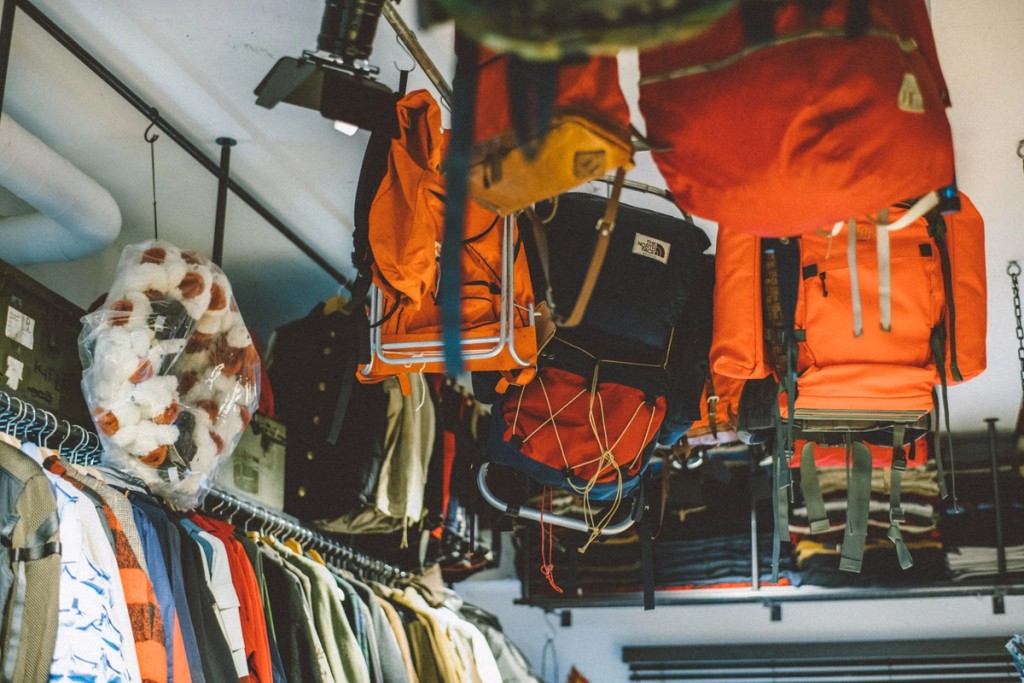
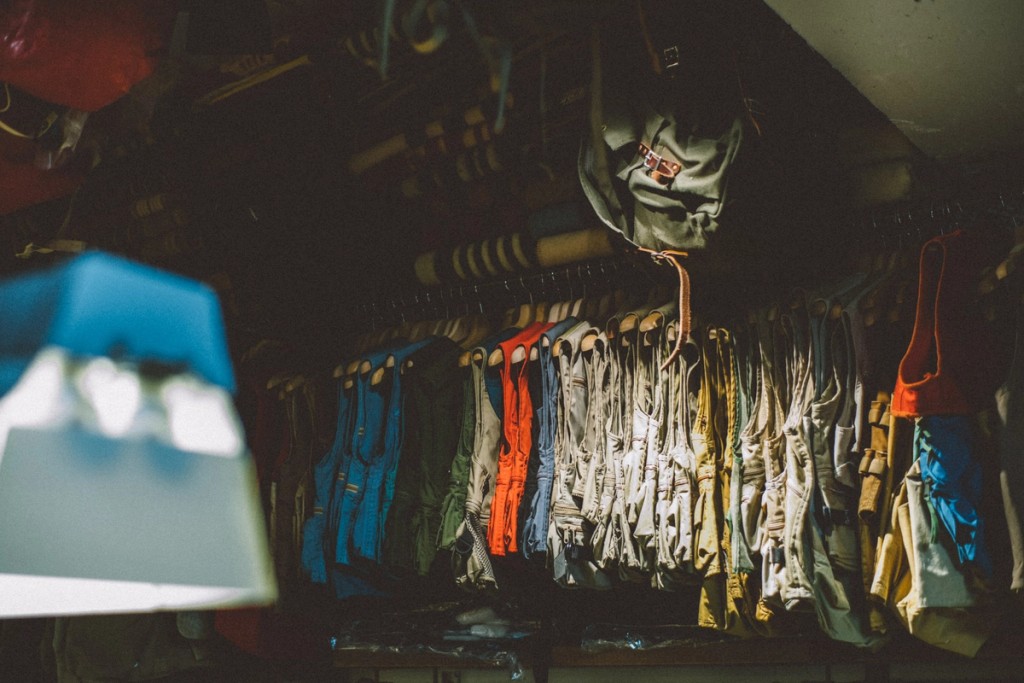
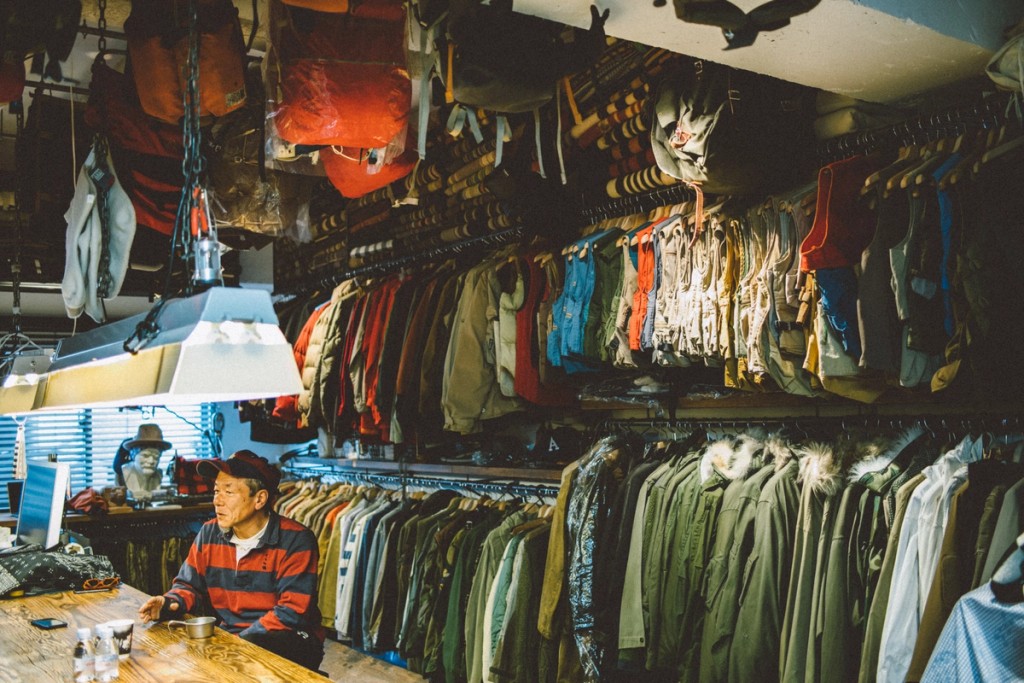
Can you tell us about your beginnings? What drew you to the world of design and fashion?
I started out in the footwear industry. I was born in Asakusa, where my father ran a shoe factory; our family lived on the second floor of the factory. My father would design the shoes and a team of craftsmans would make them. After graduating high school, I went to work at an Italian shoe factory in Florence for about a year and half, before returning to Tokyo. Around this time, the Tokyo fashion scene was picking up and I was very curious, but knew nothing other than footwear then. I decided to work for a small Japanese footwear company that designed footwear for several Tokyo runway shows in the 1980’s. After spending five years there, designer Takeo Kikuchi asked if I could help design the footwear for their collection. This is where, I believe, I was getting closer to my goal of creating my own clothing line. During this period, I observed the interesting movement culminating through both Jun Takahashi and his many Ura-Harajuku peers in the early 90’s. I thought, well since I’ve always taken an interest to fashion, why not try my hand at designing clothes? Through Takeo Kikukchi, I connected with a patternmaker who helped build the framework for General Research in 1993.
はじめに、デザインやファッションの世界に入ったきっかけをお聞かせください。
実家が浅草の靴屋だったんですよ。小さな靴工場の2階が住居になっている家で、1階で父親が靴のデザインや木型を手掛けて、 職人たちが靴を作っていて。高校を卒業してからイタリアに1年半ほど住んでその間、現地の靴工場で修行を積み、日本への帰国後は東コレのランウェイショーの靴を作っている小さな会社で5年ほど働きました。85年に会社を辞めたあと、菊池武夫さんがコレクションの靴デザインをやってみないかと声をかけてくれたんです。もともと自分は靴よりも服が作りたかったから、服作りとの距離が近くなったのはラッキーでした。裏原のカルチャーが始まる頃の1994年になると、当時友人たちが始めたブランドの靴も作らせてもらったりしました。そんな中、ジョニオ君たちの服作りのやり方が面白かったので、自分でもやってみようと思い立って、菊池武夫さんの仕事で知り合った洋服作りの仲間たちと一緒に作り始めたのが〈ジェネラルリサーチ〉。1993年のことで、そこからは洋服作りの世界に入っていきましたね。
After launching General Research, what drew you to further refine the name and the brand’s mission?
General Research was my first venture into clothing design. Since I only had a background in footwear, I asked myself: What’s the best way to approach this? From there, I figured, how about starting off broad and narrow it down from there? But then I came to realize that creating such a vast range of product under one brand would make things complicated. Why not separate my interests into their individual research lines, and delve deeper from there? It would allow me to sift through, for example, outdoor-wear, naval-wear, biker-wear, and more accurately pinpoint each study.
As someone with no affiliation to any tribe, collective or fashion group, I chose to approach clothing from a place of personal interest. Rather than following a trend, or collaborating with peers, I was intrigued by researching the many facets of clothing that existed. My exploration always starts from the size of a Lego block, and expands through further investigation and understanding. Without that starting interest, the research doesn’t come to fruition.
〈ジェネラルリサーチ〉から〈マウンテンリサーチ〉にブランドの名前を変えた理由と、ブランドのミッションについてを教えていただけますか?
もともと靴作りからこの世界に入ったので、洋服のことはなにひとつ分からなかった。「洋服を作る場合は、どういう風にするんだろう?」と、服作りに関するジェネラルなことを中心に色々とリサーチをするわけじゃないですか。それで〈ジェネラルリサーチ〉という名前を付けたんです。〈ジェネラルリサーチ〉はどちらかと言うと一般的な(ジェネラルな)リサーチに基づく、街がイメージの服だったんだけど、その後山やキャンプの方が面白くなってきて……。ただ、1つのブランドの中にアウトドアやミリタリーが混在していると、やりにくでしょう。だから最初の〈ジェネラルリサーチ〉から派生して、アウトドアに特化した〈マウンテンリサーチ〉、海軍に焦点を絞った〈ネイバルリサーチ〉など、その都度名前を変えることにしたんです。でも、やっていることはいつも同じ。「リサーチ」をしているんですよ(笑)。
個人的に何かに興味を持って、ある対象をリサーチしているという構図はずっと変わらないんです。洋服作りに関する教育を受けたこともないから、フッテージというか、参照になる資料が目の前にないと何もできない。かつ、レゴブロックを組み立てるようにしか作れない。自分にとって服作りは、リサーチをしながら素材を組み合わせてパズルをしているようなもの。 だからリサーチの対象がないと始められないんですよ。


What are some of the design inspirations for your work with Mountain Research?
When I first started Mountain Research, 1960’s mountaineering gear interested me the most. A bit after the Korean War era, there was an excess of military wear that had been stocked up. A lot of these pieces were then dropped off at military surplus stores for people to buy. The wide array of pieces, like sailor hats and M-65 trousers worn with leather mountain boots and white button-up shirts, were really intriguing. I remember thinking how neat it was, seeing photos of the Patagonia founder, Yvon Chouinard, wearing this clothing on the mountains. This generation of military silhouettes shaped the building blocks for Mountain Research.
〈マウンテンリサーチ〉のデザインを展開する上で、何から影響を受けましたか?
一番影響を受けたのが、60年代の山登りの洋服や道具です。50年代の朝鮮戦争時代の頃の軍服がアメリカでは過剰に余っていて、60年代になるとミリタリーショップで売り出されるのだけど、当時山で過ごそうなんて考える若者たちはお金がないから、そういったサープラスアイテムを着て山に登っていたんだよね。セーラーハットをかぶって、M-65の軍パンを履いて。そういった類のミリタリーに革の登山靴を合わせて、白いボタンダウンのシャツを着てて。特別な場所に特別なものを着て行かずに、身の回りで簡単に手に入るもので山に登るあの時代の雰囲気がすごく好き。〈パタゴニア〉の創始者イヴォン・シュイナードも、当時の写真を見ると普段着を山で着ているんだよね。
Mountaineering garments have significantly influenced the brand’s identity, but music has played a large role as well. Can you share some of the musical inspirations that shaped the identity of your brand?
Well, I was born around the 1960’s, so from elementary school I was listening to the likes of The Beatles and many other English artists. My interests migrated to punk once I reached high school. After graduating high school, I went on to work in Italy at the end of the 70’s, around the disco boom. Upon returning to Tokyo, I was listening to Talking Heads, David Byrne, et cetera.
For about ten years now, I’ve been only listening to Phish [laughs]. I get a feeling similar to sitting in a nice hot bath for an extended period of time when I listen [laughs]. The moment in which I chose to start Mountain Research came during a 2004 Phish show that I went to. It was a four-day camping concert that took place in a deep woodland area of Maine. The use of oversized garments, combined with bits of nylon and cotton, I thought was so stylish and fashionable [laughs]. More so than the people of the cities, the people around the festival grounds had so much style.
I was so intrigued by the alternative aesthetic. Seeing the people by the mountains, all gathered for this Phish show in their unique styles, impacted my outlook on clothing. I figured, why not try to bring this same feeling to the mountains of Japan? This then sparked my search for a mountain location. That soon evolved into changing the name of General Research to Mountain Research; there was no turning back. Through deeper thinking, I came to realize that the 2004 Phish concert had created the shift. I wanted to find a way to bring this free, alternative way of life back home with me to Japan.
登山服が特にブランドの形成に影響を与えていますが、音楽の要素も見受けられますよね。どんな音楽がブランドに影響を与えているのかをお聞かせください。
1960年代生まれなので、小学校の頃からビートルズなどイギリスのアーティストの音楽を聞いてきました。すごく大きな影響を受けたのは、高校の頃に出会ったパンクですね。その後に高校を卒業してイタリアに行ったのが70年代の終わりで、ちょうどディスコブームの時代でした。東京に戻ってきた頃はトーキングヘッズや、デヴィッド・バーンがやっている音楽が面白い時代でした。
とは言うものの、その実ここ10年はフィッシュしか聴いていないんですよ(笑)。ずっと浸かっていられるお風呂を見つけたような感じで、気持ちがいいんです。
〈マウンテンリサーチ〉をはじめたきっかけも、2004年にフィッシュのライブを見たから。ボストンから車で8時間ぐらい走ったメイン州の森の中で、3日間キャンプインして参加するショーです。そこに集まっていた人々はアウトドアウェアでがっちり身を固めた人はいないし、とは言って単にヒッピーのような感じでもない。みんなすごい適当な感じがこれまた良かったんだよね。彼らが選ぶ服のサイズ感や、コットンとナイロンの組み合わせもめちゃくちゃ洒落ているなと思って。 いろんなものが混ぜこぜになっていて、みんな適当で(笑)。街中で見る人たちよりもはるかに面白かった。
このキャンプインを体験して、オルタナティブなやり方みたいなものが何なのかが明確に分かった。自分の好きなものを持ち込んで自分の好きなようにしながら山に居るということ、というのかな。山の中でフィッシュのライブを見ている感覚と、同じことを日本の山の中で個人的に再現していきたいなと思ってね。それから山の場所を探しはじめて、自分たちが向いている方向をはっきりと理解してもらいやすくするために、〈ジェネラルリサーチ〉から〈マウンテンリサーチ〉にブランドの名前も変えたんです。
名前を変えたら簡単に逆戻りもできないしね(笑)。それまで住んでいた世界と、フィッシュのライブを楽しんでいる世界は、全然違うもの見えてしまって……。オルタナティブな生き方とか、オルタナティブな仕事の仕方をものすごく深く考えさせられるきっかけになったのがフィッシュのライブでの体験だったんです。
You’ve touched on how fashion and music played a part in your journey. Was nature also an important theme for you?
When I was a child, I used to spend my summers visiting my grandfather in Nagoya. He would often go hunting in the Suzuka mountains, and being an only child, I would tag along with his hunting group. Each summer, I would spend up to forty days at a time with the group. I would go on these trips all the time, way up until high school. Although I didn’t know much about mountaineering and camping, I became accustomed to spending long periods in the mountains during this time.
ファッションと音楽が小林さんに与えた影響についてをうかがいましたが、自然も小林さんにとって重要なテーマでしたか?
子供の頃は名古屋のおじいちゃんの家で毎年夏休みや冬休みを過ごしていました。祖父は三重県の鈴鹿山脈に狩の飯場(はんば)を持っていて、男ばかりで狩りをしている所で毎年40日間くらいずっと一緒に過ごすんです。それが高校生になるまで毎年続きました。だから登山やキャンプのことはよく知れないけれど、山でずっと過ごすことには慣れていて。フィッシュのライブを見たときに、この感覚だったら俺は分かるって思った。自分で理解できて、ピンとくるものがあったから、名前を変えてまで〈マウンテンリサーチ〉としてやりたかったんです。
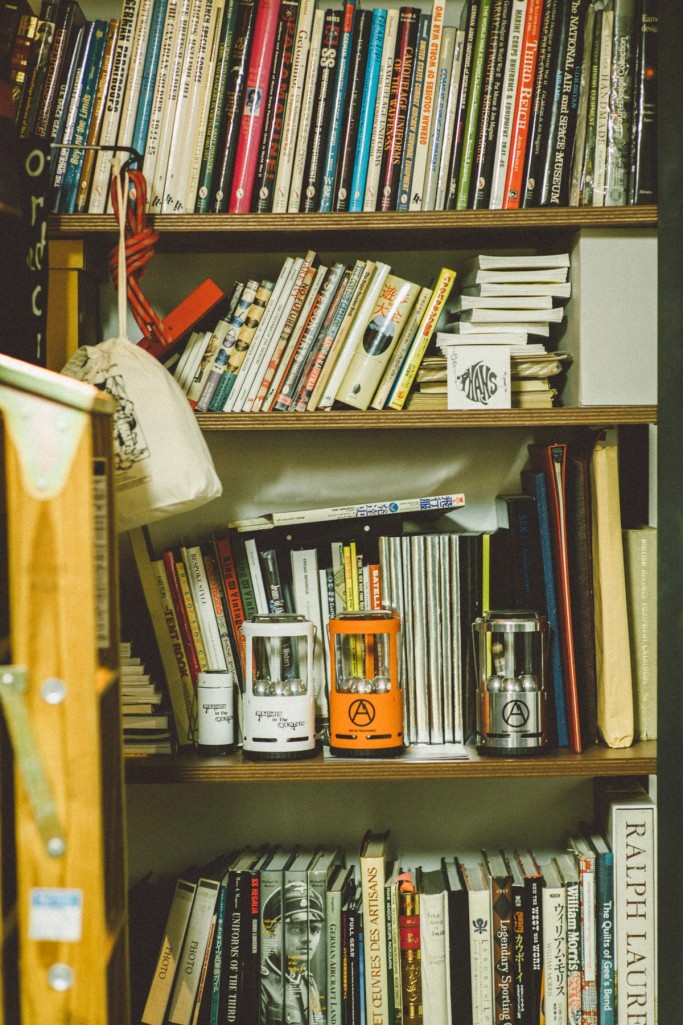
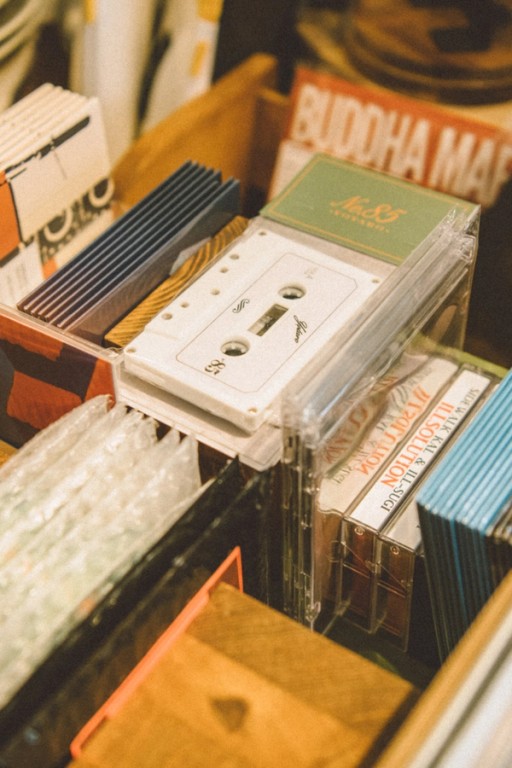
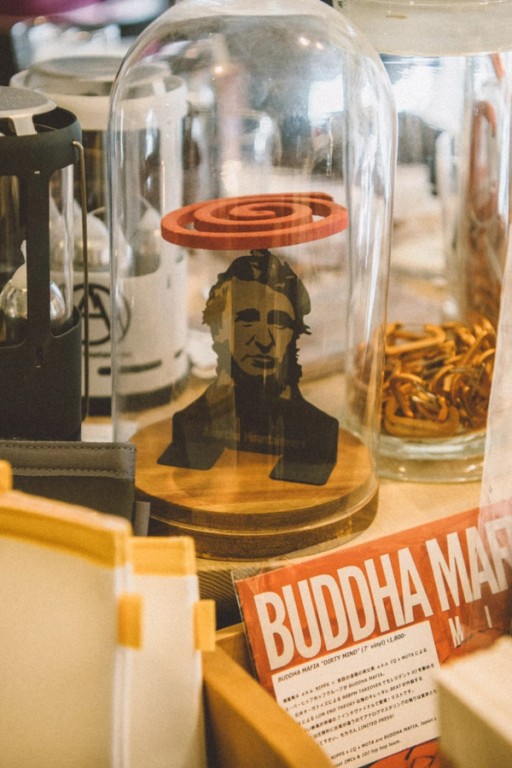

Can you talk about your emphasis on practical, functional and utilitarian clothing?
Yes, it’s something I value highly. For Mountain Research, I test run all our samples at the mountains to see how they fare in that environment. When I make a sample, I always make my own size. I need to actually try on and see how our products function and it’s always more important that the product is comfortable and functions well for me.
服のデザインを考える上で、実用性や機能性は重視していますか?
していますね。〈マウンテンリサーチ〉は特に、自分で作ったものを山で着て作業をしています。ポケットの位置やフィット感を自分で試して直しながら作ってます。自分で実際に袖を通したり履いてみないと、全然分からないからね。サンプルをモデルに着せて見た目の格好がいいかどうかよりも、自分で着て気持ち悪くないことの方が大事。だからサンプルは基本いつも自分のサイズ、雑誌への貸し出しの都合とか気にしてやしない(笑)。
All of your collaborations seem to strongly align with the Mountain Research message. What’s the most important unifier amongst your collaborations?
When it comes to collaborations, the potential partner should have something that piques my interest, and be able to make something that we would not be able to make on our own. For instance, our recent collaboration was with Columbia: I was interested in their designs and even used a lot of them in my own collections from very early on for General Research, so I felt lucky to be able to work together on a project. With HAVEN, we had both own and run retail stores, so we were very intrigued to work with them. Typically, we don’t feel a serious urge to partake in a collaboration unless there is something intriguing for both parties. There needs to be an interest in a project before committing, otherwise there’s the possibility of losing momentum while working on it.
コラボレーションアイテムを作る場合も〈マウンテンリサーチ〉の統一したメッセージが感じられます。コラボで一番大切にしていることはありますか?
自分が興味が湧いて強く惹かれて、面白そうだと思えること。数年前にコラボレーションしたコロンビアは、〈ジェネラルリサーチ〉時代から服作りのアイデアを盗みまくっていたブランドだったから、逆にオファーをいただけたときは本当にうれしかったですよ(笑)。〈ヘイブン〉とのコラボレーションは、彼らはカナダ、僕らは東京の中目黒という風に、お互い店を持っている者同士であるところが一番のポイントになりました。実は普段はあんまりコラボレーションに乗り気ではないんですが(苦笑)、知らない世界を見せてくれそうな予感があれば喜んでやります。最初の時点で強く惹かれる話じゃないと、ノリ良く継続できずに途中で飽きてきちゃうんですよね。
Did you have any particular intentions going into the collaboration with HAVEN? Were there any choice pieces from the collection?
When first connecting with the HAVEN team, I was curious about what direction this collaborative project would take. After getting a clearer idea of their intended direction, it made total sense. With a similar understanding for design and aesthetic, I knew there was great potential to make something special together. To be honest, I really enjoyed all the pieces from the collection. I thought particular details, like the detachable fisherman pants, were unique and well executed. I enjoyed working on the collection and was pleased with how everything came together.
〈ヘイブン〉とのコラボレーションで、特にどのような点に興味を持ちましたか?
最初に〈ヘイブン〉のチームから連絡が来たときは、どんな方向性で何がしたいのかな?と思って。コンセプトが明確になってからはすぐに理解できました、〈マウンテンリサーチ〉と一緒にやりたいと思ってくれたポイントはここなんだなと。俺が好きなものをよく理解してくれているし、今回出来上がったコレクションは全部のアイテムが好きですよ。Tシャツのグラフィックやデタッチャブルにアップデートされたフィッシャーマンパンツなど、全部楽しくやらせてもらいました。
What does ‘Anarchy In The Mountain’ mean to you?
‘Anarchy In The Mountain’ holds true to how it reads. It stems from the Greek word anarcho, which translates to “a world with no governing or ruling power.” I was searching for this type of feeling in the mountains; a place where you can be left to your own devices, off the grid and without anyone to have to report to. The thought of going to a party, or clubbing on the weekends, is quite fine. But on a separate weekend, shutting off the electricity and going to the mountains is my form of an Anarcho society.
Tシャツのグラフィックに採用した「アナーキー・イン・ザ・マウンテン」の意味は?
「アナーキー・イン・ザ・マウンテン」のアナーキーは、ギリシャ語のアナーコが由来。「支配するもの無き世界」という意味です。その感覚が実感できる場所を、ずっと探していたんだよね、インフラを遮断してグリッドをオフにして、圧力から開放されるような。週末にクラブで遊ぶのも1つの手段かもしれないけれど、どこかの週末は電気がなくて、インフラのお世話にならないような場所で自分たちのことをやって過ごすのが、アナーキーな手段なのかなと。そして、それを即座に実践できるのは山の中だからね。
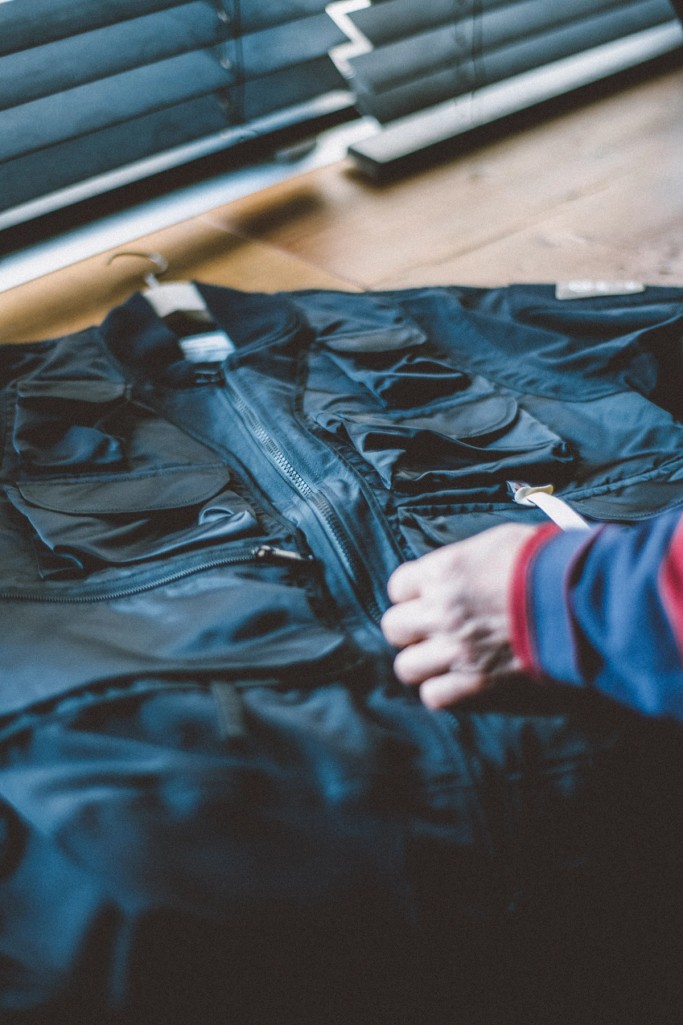
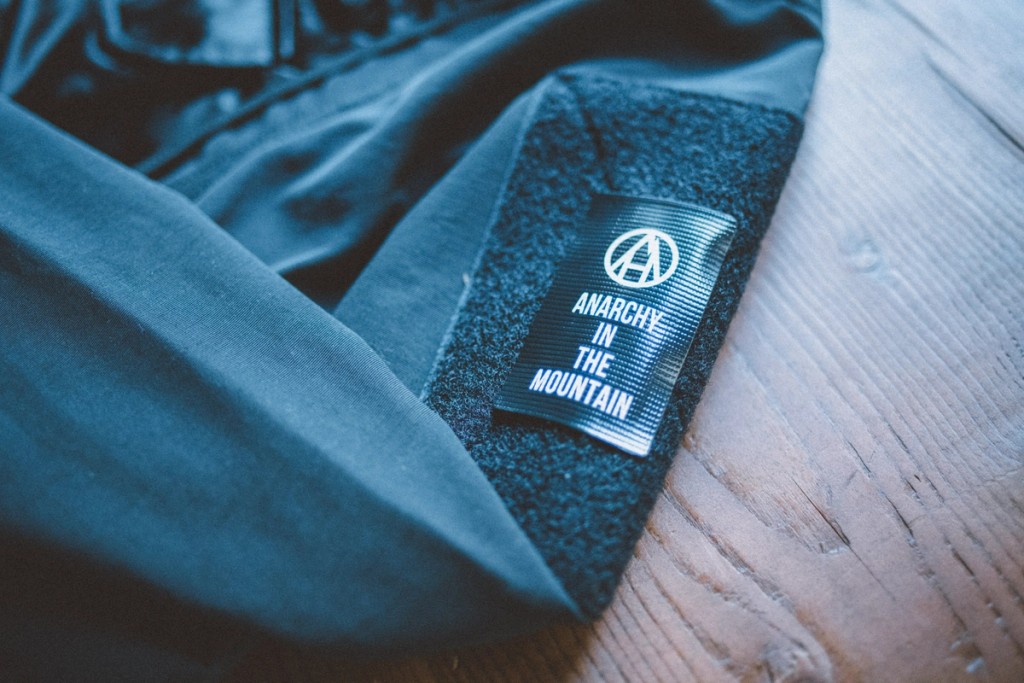
How did the ‘Platform For Living’ project materialize?
It was soon after we made the transition over to Mountain Research. We thought, if a fashion brand needed to be displayed on a runway, then what would an outdoor brand need? Since we’re not mountaineering professionals, we figured that we needed an actual location that was true to our designs and philosophy. The concept behind the brand has always been to enjoy the Japanese mountains. I want people to go out and enjoy the mountains, wearing clothes that they like. Tying into the Anarcho lifestyle, we took somewhat of a squatter mentality [laughs]. I do not want us to be mountain-y people, making mountain-y products. But I want to create our story and philosophy in the mountains and show this authentic story on the actual product. If our customers use any of our products in the mountains, then I want them to feel satisfied with them and they can say this product is very awesome. We wanted a location by the mountains to hang out. This was the fundamental idea behind Platform for Living, and we needed a site to bring it to life.
山に場所を作るプラットフォーム・フォー・リビングのプロジェクトを実現したきっかけは?
〈ジェネラルリサーチ〉から〈マウンテンリサーチ〉にブランド名を変えた直後に始まりました。ランウェイでショーをやる代わりに、具体的な場所と洋服がシンクロする状態でやりたかったのが〈マウンテンリサーチ〉なんです。だから場所の設定は絶対に必要だった。日本の山で遊ぶというのがテーマだったんですね。みんなが日本の山に好きな洋服を着て行って好きに過ごしてほしいなと。僕らが考えるアナーキーな山の生活は、山スクワット、つまり不法占拠みたいな感じですけどね(笑)。山に基地みたいなものを作って、そこで暮らしながら〈マウンテンリサーチ〉をやらなきゃいけないと思ってるんです。
山っぽい洋服を、山のプロが作って売るのではなく、自分たちの手によって山の中でできたオリジナルのストーリーを見てもらえるようになったら嬉しいね。例えそれがマニュアルに載っていなくても、どんな道具であれ洋服であれ自分たちで使ってみて、これ凄いぜ!と言えるような。自分たちでもまだ未知の世界だし、それが一番面白がいところでもある。だからこそ、具体的な場所を山の中に設定するのが〈マウンテンリサーチ〉には絶対に必要だった。
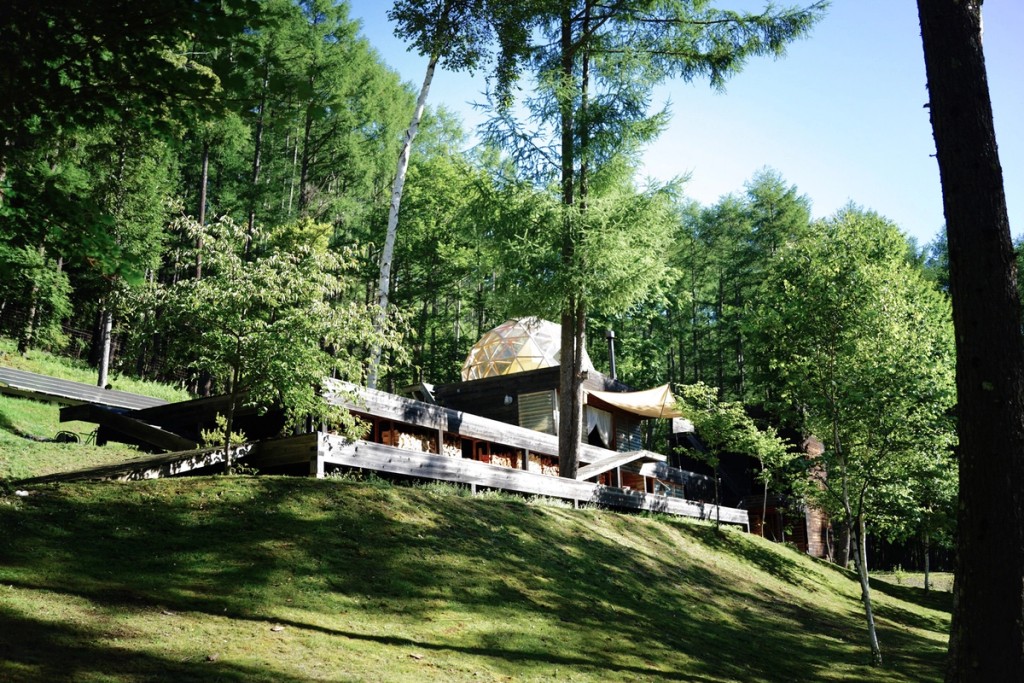
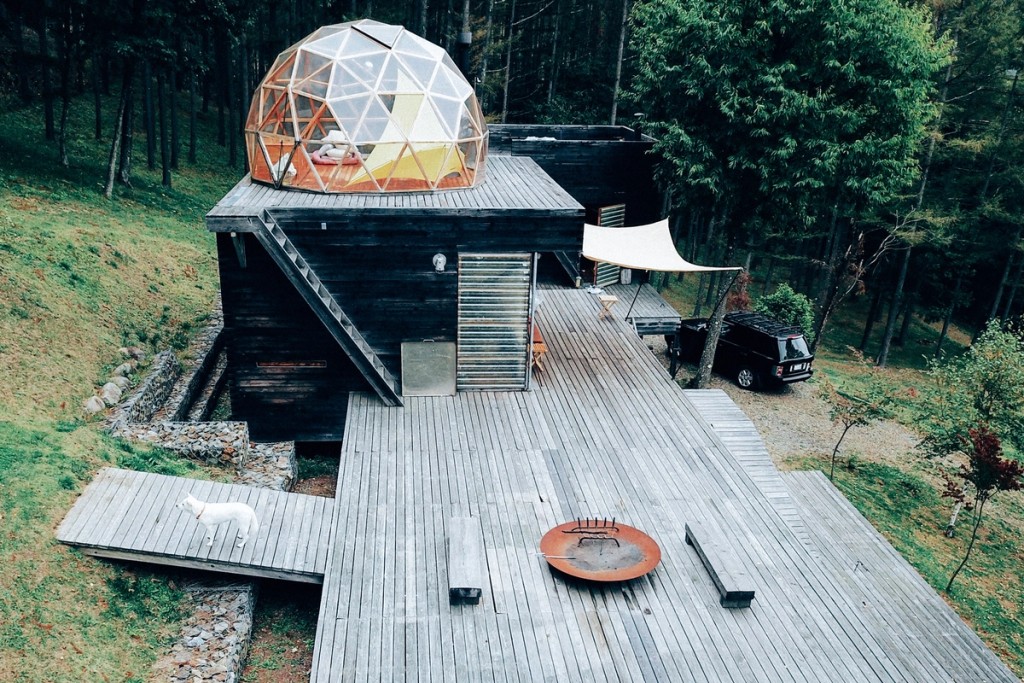
Was there a reason why you chose Nagano Prefecture for your retreat?
When starting our search, we wanted an accessible location, ideally within a two hour drive from Tokyo. However, that was short of options so we extended our range to within 2.5 – 3 hours. During our search, I was reading a lot of books and essays by Yoshio Tabuchi, an author who moved to a mountain 30 years ago and wrote an essay about his time at the village there. After reading it, I had cemented in my mind that this was the kind of environment I needed. After further research, I went to the same village and visited the land owner. We expressed our interest in the location and the need for an untouched site that we could build this project around.
プラットフォーム・フォー・リビングに長野県の山を選んだ理由を教えて下さい。
山を探し始めた当初は東京から車で2時間以内のアクセスしやすい距離内で探したけど見つからなくて、2時間半から3時間の距離まで広げて探しました。作家の田渕義雄さんが30年以上前に書いたエッセイを読んでようやく辿り着いたのが川上村。東京から車で3時間ぐらいの場所。実際に川上村に行って、こちらの要望を伝えて山の持ち主に場所を見せてもらうと、そこは本当の手つかずの山。思い描いていた通りの場所を見て興奮して、すぐに決めてゼロから開墾しました。
Were there any guidelines that you gave Shin Ohori and the General Design team for this development?
Yes, I knew I wanted two, 2-meter dome tents to act as bedrooms on the roof of the structure. We also wanted to strictly use natural materials from the village area when building. Keeping the wooden walls and surfaces free of paint was another request of ours. In order to preserve a 100% compostable development, we avoided the use of any paint or chemicals. If any of the wood in the structure were to deteriorate, we would replace it, one piece at a time. Those were the basic guidelines that I requested.
プラットフォーム・フォー・リビングは、大堀伸さん率いるジェネラルデザインが設計を行いましたがどのようなやり取りをしましたか?
〈ノースフェイス〉の2Mドームテントを2つ、建物の上部にベッドルームとして設置することは決めていました。あとは土地にある自然の材木で建てることかな。木の表面にペイントや加工も何もしないことも条件でした、最後には腐って100%土に還ってもらわないと困るから。思っていたよりも早くぐずぐずと腐り始めたりしているので、部分的に腐っている箇所を修理しながら使っています。
How does the retreat contribute to your creative process?
I’m not sure if I can directly say it contributes to our creative process; maybe more so to research and development. I never go to the mountains with the aim of creating something or to develop a new idea. I mean, to be fair, I don’t really have much free time to think about future ideas. When I’m there, I am so busy with upkeep and maintaining the estate. In the summer, we need to trim all weeds on the surrounding land. In the winter, I need to chop down trees to supply wood for daily use.
I’ll say though, while doing these chores around the estate, we wear and test our products. If I notice a zipper placed in a slightly inconvenient area, or the sleeves are too tight for easy mobility, then I take mental notes. These are the types of things I could never forget, especially if it hinders the user experience. Once the day’s tasks are finished, I’m usually way too beat and pass out [laughs]. Essentially, I never really have the time to draft up new designs.
山の中の生活はデザインやクリエイティブにどのように影響を与えていますか?
デザインや服について山の中で考えるみたいなことをやりたいと最初は思っていたんだけど、いざここに来ると作業に追われるばかりでゆっくり考えられないんだよね(苦笑)。というのも、山にいると夏はどんどん伸びてくる草を刈らなきゃいけないし、冬は木を切って木材を調達したり建物をメンテンナンスしたり。それで山に居る時間は終わっちゃう(笑)。
でも作業をしているときに、サッと物を取ろうとする際のポケットの位置や角度や深さ、スリーブのタイトさなどは覚えているじゃない? 特に不便だった感じは絶対に忘れない。それを覚えていて東京に戻ってきたときに直します。作業が終わると疲れてヘトヘトになって寝ちゃうことばっかりだから、山では実際に一切デザインのことは考えられない……。
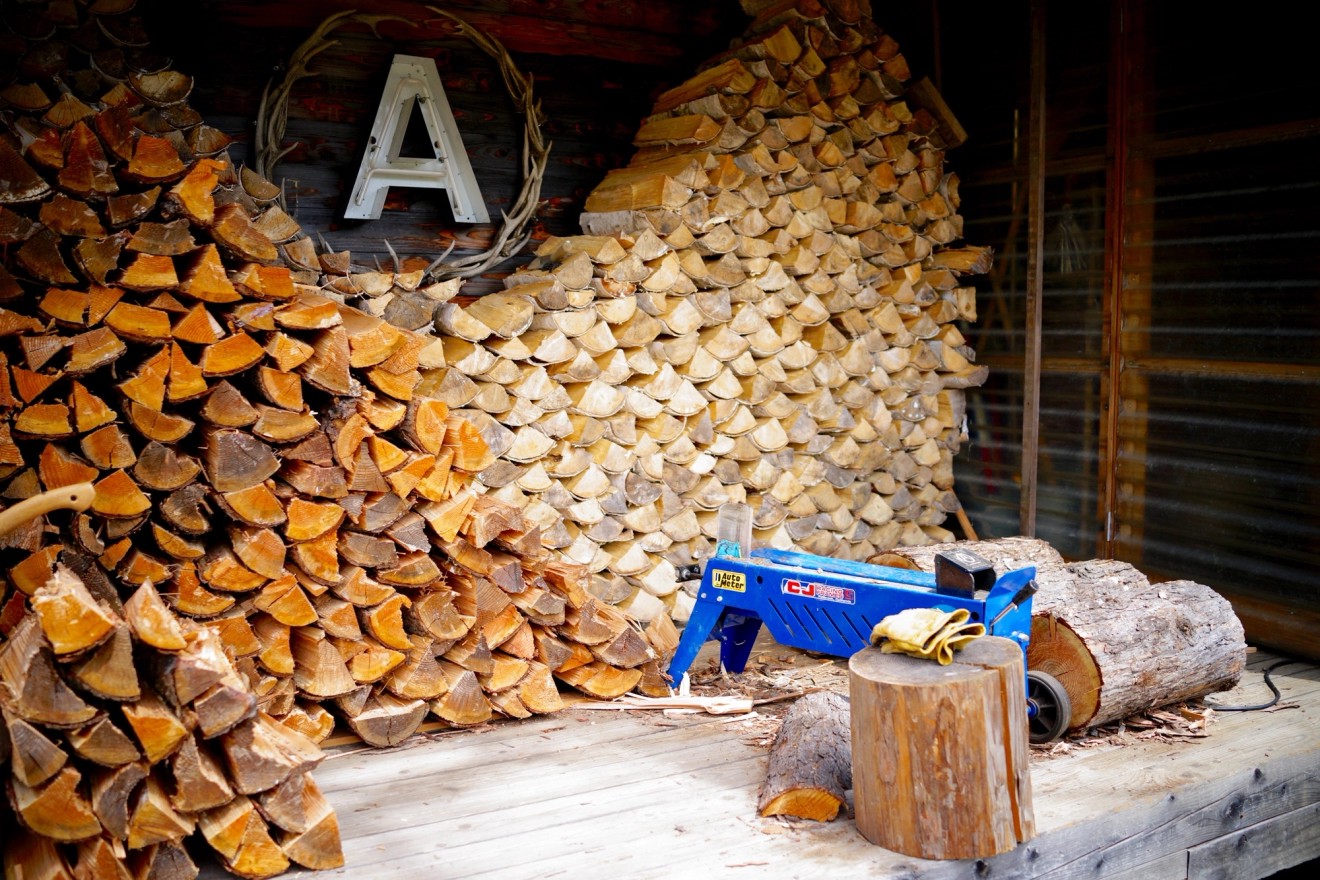



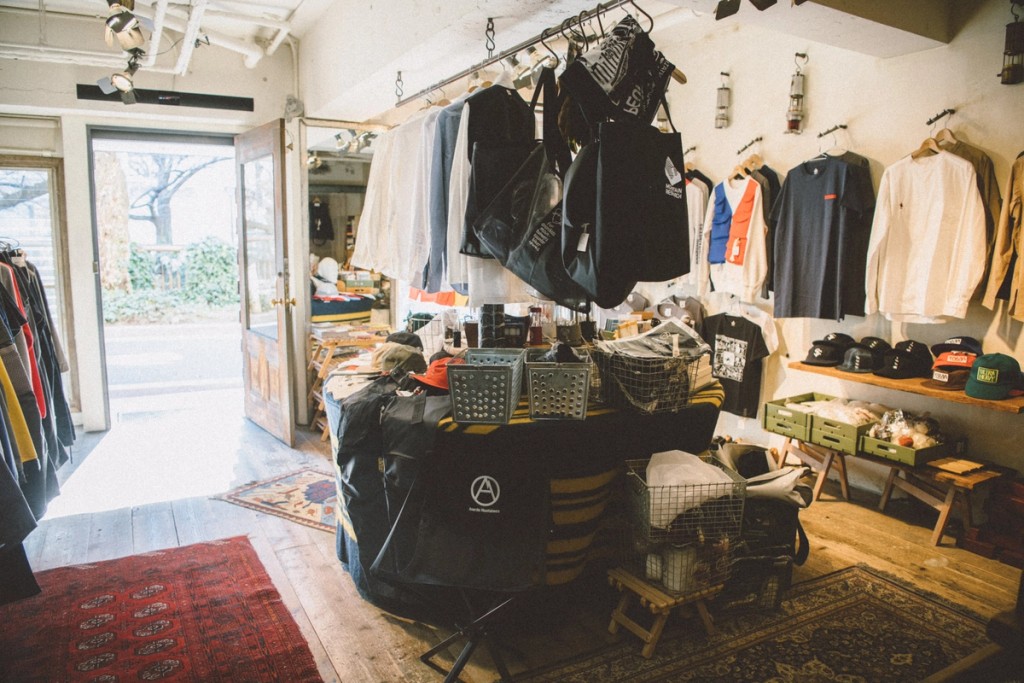
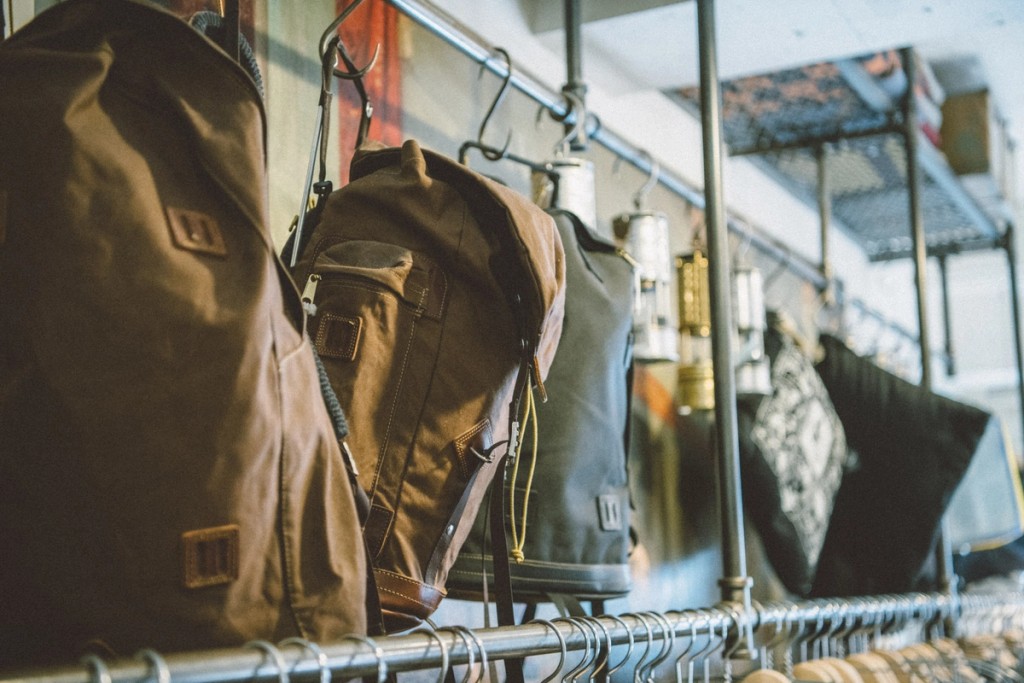

Interview: Orion Johnson | Translation: Kozue Sato | Photography (Atelier, General Store): Takehiro Goto